Misyon Online - November-December 2009
RESPONSES FROM THE YOUTH (A CONTEST)
Featuring: ‘YOUTH OF THE NEW MILLENNIUM’
‘Youth of the New Millennium’ (Do you know where we’re going to . . ?) is written by a teacher telling us of her many observations about the youth of today. However, she doesn’t sound so positive about it. You can access the article here.
In this connection we would like to cater responses from the youth on this article. We will be accepting entries either by email (editor@misyononline.com) or by post (San Columbano, PO Box 588, 6100 Bacolod City) on or before December 31, 2009. We will give three prizes of PHP1,000 for the responses that in the editor’s judgment are best.
Youth, it entails the concerns of your generation. Let your voices be heard!
!!! Click here to check on MISYON Student Essay Contest 2009 WINNERS !!!
This is a post script to the Misyon Pulong ng Editor November-December 2009 Issue.
‘Chaty' for Charity Work
By Mary Joy Rile
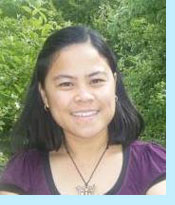 Four years ago Chaty started a charity work by doing fund raising for an orphanage in Dumaguete. She collected some money from her friends back in Australia and bought goods such as rice, milk, sugar and biscuits as Christmas presents. Before returning to Australia she happened to pass by a second-hand store, popularly known here in the Philippines as ‘ukay-ukay’, where she saw a Salvation Army tag on some clothes. These were supposed to be given out free, not to be sold. This gave Chaty the idea for another charity work...
Four years ago Chaty started a charity work by doing fund raising for an orphanage in Dumaguete. She collected some money from her friends back in Australia and bought goods such as rice, milk, sugar and biscuits as Christmas presents. Before returning to Australia she happened to pass by a second-hand store, popularly known here in the Philippines as ‘ukay-ukay’, where she saw a Salvation Army tag on some clothes. These were supposed to be given out free, not to be sold. This gave Chaty the idea for another charity work...
Read more
A Missionary from Colombia
By Richelle Verdeprado
 Opportunities to decide how they will spend their lives come in different ways for different people. More than just recognizing these chances is the permanent joy brought about by listening and responding to them according to God’s plan. For Sr Adela V. Paternina TC, her opportunity to decide how she would live the rest of her life came to her 57 years ago, when she chose to enter the Capuchin Tertiary Sisters of the Holy Family, a religious congregation founded at the shrine of Our Lady of Montiel in Benaguacil, Valencia, Spain, by Bishop Luis José María Amigó y Ferrer OFM Cap. Now, as her 78th birthday is approaching, she sees her life as simpler but more real than it was before...
Opportunities to decide how they will spend their lives come in different ways for different people. More than just recognizing these chances is the permanent joy brought about by listening and responding to them according to God’s plan. For Sr Adela V. Paternina TC, her opportunity to decide how she would live the rest of her life came to her 57 years ago, when she chose to enter the Capuchin Tertiary Sisters of the Holy Family, a religious congregation founded at the shrine of Our Lady of Montiel in Benaguacil, Valencia, Spain, by Bishop Luis José María Amigó y Ferrer OFM Cap. Now, as her 78th birthday is approaching, she sees her life as simpler but more real than it was before...
Read more
A Taste of a Missionary Journey
By Nelson A. Barbarona SVD
 Japan is a country of few Christians, particularly Catholics. As far as my little knowledge is concerned, Japan in its refusal to be conquered by the different religious orders, persecuted quite a number of religious missionaries and lay persons including the first Filipino Martyr, Saint Lorenzo Ruiz. On 24 November last year 187 martyrs were beatified in Nagasaki City. Despite the persevering efforts of the religious missionaries to spread Christianity, most Japanese remained firm in their traditional belief, Shinto, which eventually became the national religion until Buddhism was introduced in the pre-war period...
Japan is a country of few Christians, particularly Catholics. As far as my little knowledge is concerned, Japan in its refusal to be conquered by the different religious orders, persecuted quite a number of religious missionaries and lay persons including the first Filipino Martyr, Saint Lorenzo Ruiz. On 24 November last year 187 martyrs were beatified in Nagasaki City. Despite the persevering efforts of the religious missionaries to spread Christianity, most Japanese remained firm in their traditional belief, Shinto, which eventually became the national religion until Buddhism was introduced in the pre-war period...
Read more
Fiji Day Celebrations in the Philippines
By Etuate Tubuka
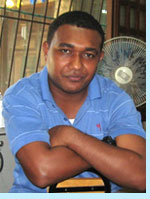 I woke up in the morning of Saturday 11 October last year with a feeling of great delight and cheerfulness for it was the day we Fijians here in the Philippines were going to celebrate Fiji’s Independence from Great Britain. The actual date of independence is 10 October but since it fell on Friday, a working day, we decided to have the celebration the following day.
I woke up in the morning of Saturday 11 October last year with a feeling of great delight and cheerfulness for it was the day we Fijians here in the Philippines were going to celebrate Fiji’s Independence from Great Britain. The actual date of independence is 10 October but since it fell on Friday, a working day, we decided to have the celebration the following day.
Exactly 134 years earlier Fiji was ceded to Great Britain due to unpaid debts to some Americans. Fijians then were living under the traditional chiefly system and money was of no value...
Read more
Pulong Ng Editor
This is a post script to the Misyon Pulong ng Editor November-December 2009 Issue.
'Sinful' Christmas
By Fr Frank Hoare
Greeted with hospitality and sweet tea, a Columban priest and his companion tell the story of Christmas to non-Christians in Fiji. This article won a ‘Highly Commended’ award for The Far East, the magazine of the Columbans in Australia and New Zealand where it first appeared in the November-December 2008 issue, from the Australasian Catholic Press Conference in Sydney in September.
‘You have walked all this way to enlighten us about the meaning of Christmas. You are a holy man; you are a saint; you are an incarnation of God’, a middle-aged Fiji-Indian man named Ram Samuj enthused after I had shared with him the story of Christmas. I remembered how Paul and Barnabas had torn their garments in horror when, after healing a cripple, the people of Lystra attempted to sacrifice oxen to them (Acts 14:14). My protestations of mere humanity to Ram Samuj were less dramatic, but he accepted them. No sacrifice was performed.
I was living in the settlement of Naleba about 16 kms from Labasa, the main town on the second-largest island in the South Pacific nation of Fiji a few years ago. The 40,000 Hindus and Muslims in the area weren’t beating a track to my doorstep to learn about Christianity. But I had one thing going for me: Christmas.
Their grandfathers, brought as indentured laborers to Fiji by the British, slaved six days a week, 52 weeks a year, in the sugar plantations. So the public holiday on the feast of Christmas was a welcome rest day to enjoy. Thus Christmas entered the calendar of the ethnic Indians of Fiji, though few were Christians. It was, however, a secular celebration for them. The vast majority were unaware of its religious meaning.
With Christmas approaching, I saw an opportunity to evangelize my non-Christian neighbors, by sharing the Good News of joy and peace signified by the birth of Jesus Christ to people of good will. I ordered illustrated pamphlets with the story of Christmas written in the Hindi language.
Armed with these pamphlets and accompanied by Sog Lingam, a young Catholic Fiji-Indian companion, I set out from Naleba. We headed toward settlements I rarely visited. I had a week to visit every house, talk with families about the meaning of Christmas and leave a pamphlet for them to read. I decided to do it in the traditional way of an Indian religious man - by walking and meeting the people.
A Different Meaning of Christmas
I was unprepared for the welcome and hospitality we received everywhere. When we came close to a house, we would first announce ourselves, asking for the dog to be restrained. Inevitably, we were offered a seat and, without waiting for any explanation of our presence, the woman or daughter of the home would bring tea.
In the Indian culture, a guest must be welcomed and treated with kindness because, it’s believed, he could be God in disguise. Then, as we sipped the hot tea, we explained where we were from and why we were making this journey.
All those in the house and sometimes neighbors too, would gather around us as I went through the routine.
‘You know that Christmas is coming?’
‘Yes’, would be the reply.
‘Do you know the meaning of Christmas?’
‘Yes. It’s a holiday. We kill a goat, make curry and have a big feed. The men drink whiskey and beer, the women and children drink soft drinks. Christmas is a sinful day. Look at all the animals that are killed for food and all the alcohol that is drunk.’
The idea of Christmas as a sinful day knocked me off balance. But it did introduce the topic of sin and its opposite, redemption.
I explained how God sent His Son to save the world from sin and its consequences and how this Son, Jesus Christ, was born of poor but religious parents in Bethlehem. This child was God’s greatest gift to a sinful world. He would defeat Satan and inaugurate God’s Kingdom of justice and peace. The angels, knowing this, sang their hymn of praise announcing peace to people of faith and goodwill.
The villagers listened with rapt attention. They examined the pictures with interest.
They could identify with the shepherds and magi who brought their gifts for God’s Son. We would then leave them the Hindi pamphlet and, asking them to say a special prayer on Christmas Day, Sog Lingam and I would move on to the next home.
The hospitality created a problem for us: There is a limit to the sweet tea a person can drink. I soon reached my limit, yet I knew that to refuse the hospitality would be a refusal to accept our hosts. We solved the dilemma by asking, in most houses, for a little water instead of tea.
Walking in the heat was sweaty work, so drinking plenty of water was no problem.
No actions behind words.
On the fourth evening we met Ram Samuj. He greeted us enthusiastically and invited us to sit in a shady spot on the grass. Together we drew the contrasts between the secular and religious celebration of Christmas.
His response was both unexpected and extravagant. I emphasized our shared need for Christ’s redemption. We agreed on the importance of a more spiritual celebration of Christmas.
A few weeks after Christmas, I attended a funeral in the same area. Afterward, I asked a local villager how my friend Ram Samuj was.
‘Oh, that is sad’, he answered. ‘He was drinking alcohol on Christmas Day until he got drunk. Then he went outside and began to curse and swear at a neighbor with whom he had a grievance. He got into a fight. The police were called and now he is in jail.’
Fr Frank Hoare was ordained in 1973 and has been a missionary in Fiji, Australia and the United States. He also served a six-year term as a councilor in the Central Administration of the Columbans.
'YES Camp' In Bethlehem: A Third Year Of Success
Christian and Muslim youths play, learn and pray
By Monnitte V. Monana
The author is from Banate, Iloilo, and Meliza Panes who is featured in the story and took the photos is from Passi, Iloilo. They are both members of the Teresian Association.
BETHLEHEM (Holy Land) (October, 2008). - A mixed group of 41 young Christians and Muslims enthusiastically participated in the five-day Youth Encounter Summer (YES) 2008 organized by thePontifical Mission Library-Bethlehem (PML-Bethlehem) in cooperation with the Teresian Association (TA) in the Holy Land. With the theme Unity in Diversity, the camp focused on activities and dynamics to awaken a sense of social awareness and responsibility among the participants, no matter how different they might be.
Monnitte V. Monana, PML director and over-all organizer, together with Meliza Panes of the TA and two other local staff, Hala Batarseh and Iyad Ali, facilitated this year’s third summer youth camp which was held from 2 to 6 July last year at Betharram Seminary, Bethlehem.
The learning process was made possible through modular sessions that allowed the youth to do things together in an atmosphere of trust, respect, and acceptance of what is different and unique in others, while promoting the value of tolerance, and learning to appreciate plurality and diversity by taking concrete actions.
Furthermore, the activities were complemented by the exposure/immersion experiences wherein a day was dedicated for planting trees in a public park in Bethlehem, followed by a significant visit to the Home of the Elderly run by the Antonian Society and a ‘walk and see’ experience in some of the busy streets of Bethlehem.
These experiences, new and unique for all the participants, increased and awakened their sense of service, social commitment and sensitivity to the needs of those who are economically and/or socially deprived in society, and helped them become more aware of their social responsibility to keep the environment clean and take care of it.
On the first day of the camp, Monnitte Monana warmly welcomed the participants and stressed the need to use their potential and giftedness in building community, to unite in their efforts to make a change as well as create an environment where everyone feels accepted despite the cultural and religious differences, which in effect challenged them to start in their here and now.
‘Responsibility is a task of everyone regardless of age, gender, profession and economic status in society wherever we are – whether at home, school, village and country in general’, said one of the invited speakers, Dr Jeanne Kattan, Head of the English Department at Bethlehem University, a Palestinian who has taught at the university for more than 30 years, who spoke on commitment and responsibility.
This sense of social commitment was further complemented by a video presentation and group dynamics as well as participation, introduced by Nina Gedeon. The session allowed the participants to get in touch with different situations wherein they learned how to conserve a limited supply of water especially in the Palestinian context – at home, in schools, in their neighborhood, and in the villages. Eventually, the presentation helped the participants to think of the many ways of water management and help in its conservation.
The experience of planting trees delighted and challenged the participants to consciously take care of the environment and promote ‘green and clean’ activities. Divided into groups of four, participants and staff went together to the Mary Doty Park in Bethlehem on the second day of the camp, and each group took charge of planting trees and some flowering plants in the park. For many, the experience was unique and while having a great time planting trees they felt pride for having helped to counteract climate change even in their own simple way.
Participants and staff went to the Antonian Society and spent some time with the elderly there by simply talking, listening, entertaining, assisting them in their needs and even feeding them during meal-time. This moved and touched many of them as they became more aware of their social and moral obligations toward the sick and the elderly, and how to treat kindly those who are physically fragile in their family.
‘My heart was moved and wanted to put compassion where there is misery, love where there is hatred, and tenderness where there is insensitivity’, said Jihan Gedeon, one of the participants.
Many heads turned as a group of YES participants, each accompanied by a staff member, were walking on some of the major and busy streets of Bethlehem under the scorching sun. It was a ‘walk with a cause’. This was meant to make them become more aware and notice how clean and orderly their surroundings and cities were or were not. It enabled them to feel more responsible for their own surroundings and to keep them clean and orderly.
In spite of their different beliefs and ways of praying and calling on God, participants became one and prayed as one at the beginning of each day. The ways of praying were varied in order to accommodate all of the participants without them feeling offended or isolated, but rather allowing the atmosphere of respect and tolerance during those moments of prayer.
On one occasion the whole experience of the day was recapped by drawing out reactions and insights from the different groups of participants. The comments were translated into a prayer. Then, written in pieces of papers that were linked to make a chain, they were tied to a bunch of balloons and let go, off into the air.
Through ‘role playing’, participants also familiarized themselves with the various social problems affecting people. Later on they were invited to engage in some concrete actions to resolve the social problems in Palestinian society.
‘It was wonderful! It was the best camp that I ever went to. I learned a lot of things, and had a great time especially when we went to the Mary Doty Park and planted trees’, Said Izzat Salameh at the end.
‘This year’s camp was special and unique in ways of presenting new things which were more exciting than the previous years”, Said Hala Batarseh, who had participated in previous experiences.
For Samar Sabat, a staff member, ‘Spending time with children is the most exciting thing in facilitating camps’.
Jihan Gedeon said that through the camp ‘I have met lots of new friends who have made my life different and full of happiness and peace’.
A Bridge Between Taiwan And The Philippines
By Joy Ampiloquio and Jojoh Lepatan
The authors are members of the Teresian Association (TA or Institución Teresiana) working in Taiwan. Joy, from Bislig City, Surigao del Sur, has written for Misyon before. Jojoh is from Cebu City. Here they report on the experience of a group of students from Tainan, Taiwan.
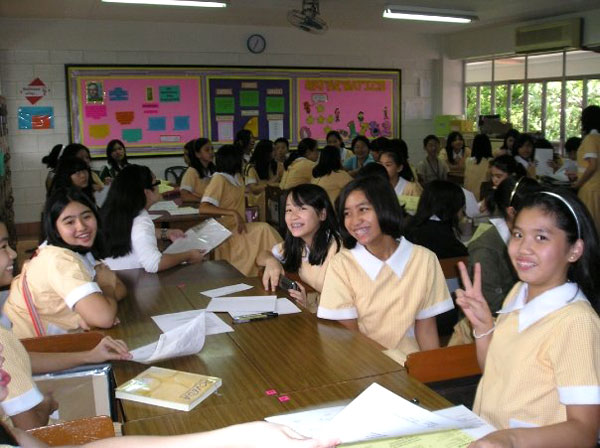
Last July, on their return from a two-week stay in the Philippines where they had done volunteer work and had an experience of learning English, thirteen young people from the Poveda Friends group in Taiwan expressed their satisfaction and their willingness to go back and do it again this year.
Annie Lin, a first year junior high school participant, taught a kindergarten class and upon coming home remarked that she needed to go back to see her ‘18 children’ again. In her evaluation of the experience she wrote ‘Nobody is perfect, we need to be nice to others’.
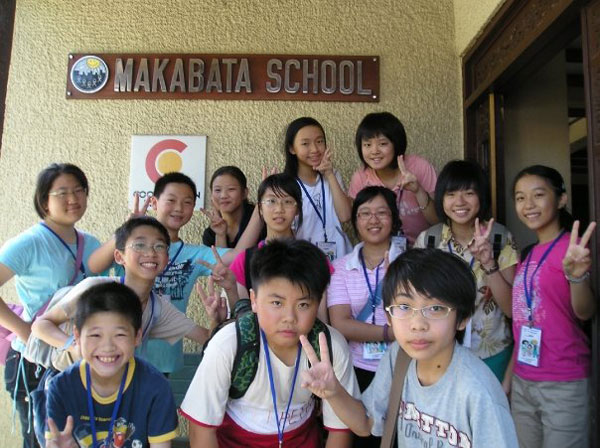
Judy Lin, a second senior high school student, would like to invite her friends to join her for this year’s program. She learned ‘how important it is to try’.
The objectives of the program that took place from 5 to 16 July were: to gather young people in the TA family and experience life in a different culture, to do some service and volunteer work and to improve English skills.
The youth shared their Chinese culture with the students in MAKABATA, a school for street-children in Barangay Sta Lucia, Pasig City, Metro Manila. The Taiwanese kids taught Chinese games, art, songs and basic Chinese expressions. And, of course, taught them how to use chopsticks.
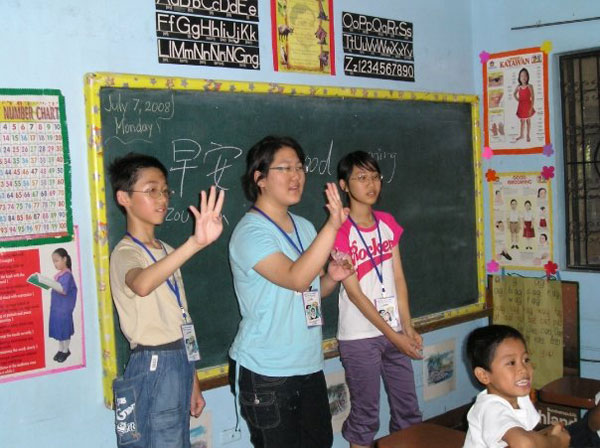
They spent the mornings teaching and being with MAKABATA kids. In the afternoons they attended classes at Saint Pedro Poveda College, Quezon City, listening to English lectures and learning how to interact with students from a different cultural background. For five days they were housed with host families and they spent two days at the TA retreat house in Tagaytay City for processing their experience and praying about it. The other days were spent in sightseeing and cultural visits.
The volunteers were accompanied by Francesca Chang, Jojoh Lepatan and Marina Ferro. Before returning to Taiwan they attended a series of preparatory formation sessions in English. Among the topics presented were: Discovering one’s values and gifts; basic attitudes towards and respect for people of another culture; serving others and getting to know St Pedro Poveda and how he founded the Teresian Association.
Full of enthusiasm and excitement, the children set off on their trip on 5 July after Mass celebrated by Fr Lito Salvador SVD who gave them an encouraging message on the importance of opening their eyes and minds to a new culture and new language. It was that message which the children brought with them as they traveled to Manila.
Although there were many inconveniences from the moment of departure and during the daily activities, the students remained enthusiastic and spirit-filled. They were tired and uncomfortable at times but were responsive and responsible enough to carry on.
Two follow-up sessions for the participants were held in August and September so that they could share the experience with parents and friends. The students had made new discoveries in sharing their culture with children of another culture, an example of what it is to have ‘the young teach the young!’ The parents of two participants from Tainan were extremely glad as they observed that, after coming back from the Philippines, their girls ‘have greater self-confidence and a greater spirit of service’. After an evaluation, TA members in Taiwan made a decision to continue the program this coming July. Formation sessions are on-going at present.
First year junior high school students James Hsiao and Ruby said that they had discovered that it isn’t easy to be a teacher, even for a short time, and that they needed more training and preparation to do it well. At the same time they said they enjoyed their experience very much and were willing to go again with better preparation.
You may email Joy at it.taiwan@msa.hinet.net and Jojoh at joleps@yahoo.com
A Missionary From Colombia
The author, from Himamaylan, Negros Occidental, is a third-year student at the University of Negros Occidental – Recoletos (UNO-R), Bacolod City, taking up social work. She has been involved in campus journalism since her elementary days and in her spare time works as an editorial assistant in the Misyon office.
 Opportunities to decide how they will spend their lives come in different ways for different people. More than just recognizing these chances is the permanent joy brought about by listening and responding to them according to God’s plan. For Sr Adela V. Paternina TC, her opportunity to decide how she would live the rest of her life came to her 57 years ago, when she chose to enter the Capuchin Tertiary Sisters of the Holy Family, a religious congregation founded at the shrine of Our Lady of Montiel in Benaguacil, Valencia, Spain, by Bishop Luis José María Amigó y Ferrer OFM Cap. Now, as her 78th birthday is approaching, she sees her life as simpler but more real than it was before.
Opportunities to decide how they will spend their lives come in different ways for different people. More than just recognizing these chances is the permanent joy brought about by listening and responding to them according to God’s plan. For Sr Adela V. Paternina TC, her opportunity to decide how she would live the rest of her life came to her 57 years ago, when she chose to enter the Capuchin Tertiary Sisters of the Holy Family, a religious congregation founded at the shrine of Our Lady of Montiel in Benaguacil, Valencia, Spain, by Bishop Luis José María Amigó y Ferrer OFM Cap. Now, as her 78th birthday is approaching, she sees her life as simpler but more real than it was before.
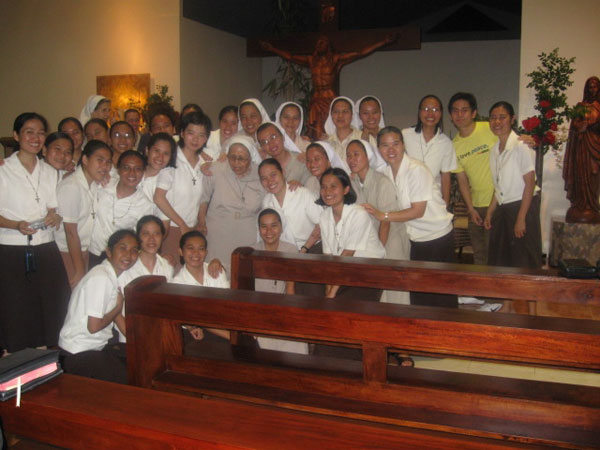
Sister Adela at Holy Family Home
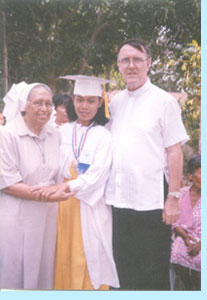 After attending a retreat during her second year in high school, Sister Adela felt the desire to give her life forever to Jesus as a missionary sister. She can still remember exactly the effect it had on her when she received a picture from a priest. The picture showed a group of indigenous people. Upon watching it, she knew in her heart that Jesus was calling her to follow Him in religious life. It was that experience that converted her into a fervent and pious person. At the age of 13, her spiritual journey started with the inspiration of St Thérèse of Lisieux whose autobiography Story of a Soul made her faith stronger. She loved reading the book because it narrates how St Thérèse lived and presented her ‘little way’ to holiness.
After attending a retreat during her second year in high school, Sister Adela felt the desire to give her life forever to Jesus as a missionary sister. She can still remember exactly the effect it had on her when she received a picture from a priest. The picture showed a group of indigenous people. Upon watching it, she knew in her heart that Jesus was calling her to follow Him in religious life. It was that experience that converted her into a fervent and pious person. At the age of 13, her spiritual journey started with the inspiration of St Thérèse of Lisieux whose autobiography Story of a Soul made her faith stronger. She loved reading the book because it narrates how St Thérèse lived and presented her ‘little way’ to holiness. Sister Adela was studying some college courses, including music, from 1948 to 1952. Before Vatican II (1962-1965), it was impossible for her to read the Bible because it was forbidden. (Editor’s note: before Vatican II it is true to say that lay Catholics were not encouraged to read the Bible lest they misinterpret it, but the Church didn’t actually forbid them to do so, though there might have been individual priests who took that line).However, nothing could stop her from worshipping and drawing closer to God. She was praying the rosary and attending morning Mass daily.
Her mother knew the Capuchin Tertiary Sisters and it was she who described to her clearly how their habit looked. When the TC sisters arrived in their place for the first time, she recognized them immediately. That was her opportunity to shape the rest of her life in a way that would eternally fulfill her soul. That was her moment to dedicate her life to God forever. She entered at the age of 20.
Sister Adela had her postulancy in Bogotá. (Editor’s note: Postulancy is a time of preparation for the novitiate which is the immediate preparation for taking vows and usually lasts two years. Today there is also a period before postulancy known as the ‘aspirancy’.) Naturally, during the first week she missed her family so much. She was the fifth child in a family of nine siblings. But because it was her heart’s desire to follow Jesus, it did not take her long to feel at home. She was filled with gladness that the sacrifices and the difficulties were so normal for her.
From 1953 to 1986, Sister Adela had her apostolic work in Colombia. She was a teacher in different schools and in the government of the province of the congregation. In 1986, she took part in the General Council of the congregation and was elected to the general council while Sr Maria Elena S. Echavarren from Spain was chosen as General Superior. She is now the superior of the Vice Province of the Philippines, which includes a community in Korea and a community in India.
Sister Adela came to the Philippines for the first time in November 1988. She was accompanying Sister Elena. After that she visited the country almost every year as part of the General Council. Visiting almost all of the places where the congregation served was very memorable for her. It gave her a lot of experience that enriched her knowledge and increased her vision about the world and the needs of its people. After 12 years, she offered herself to the new General Superior to work in the Philippines. Her offer was accepted and she was then sent to the Philippines. She arrived in Manila on 14 March 1999.
Sister Adela’s first assignment was in Talisay City, Negros Occidental. In 2002, she was transferred to the Cabug Community in Bacolod City where she lived not only with the Sisters but with the children she loves very much. Being with the girls in Holy Family Home has deepened her understanding of her vocation.
The different environment, the need to adapt to the changes that occurred after the Vatican Council and the exit of many Sisters were some of the difficulties that she encountered together with the TC community. However, through all those testing times her passion in serving God and her brothers and sisters continued to blossom. During those years, she was able to compose many songs about fraternity, justice, love for God, vocation and fidelity. Even old age cannot stop her from playing the piano and singing for the Lord. For Sister Adela, growing older means becoming more loving with people and accepting with a peaceful attitude all the physical limitations that aging brings. For her, it means remaining ever faithful and excited to learn more.
Sister Adela returned to her homeland last June but the Philippines will always be another home for her. I will never forget talking with her as I looked straight into her eyes. I will never forget her loving touch as she gently held my hand. I will always be eager to know more about her. She will always stay at home in our hearts. Sister Adela loves the Filipinos so much. She knows that God led her to the Philippines where her presence would truly make a difference. Most of the children whom she has guided and taken care of are now in college and some are leading their own lives. She has discovered her true home since the day she listened and responded to God’s invitation to her with all her heart and soul.
You may contact Richelle at rich_verde706@yahoo.com.ph and you may email Sister Adela atadelatcsf@yahoo.com
A Taste Of A Missionary Journey
By Nelson A. Barbarona SVD
Frater Nelson A. Barbarona is a Divine Word seminarian on his Overseas Training Program in Japan. He is from Bohol and has his own blog, Nelson’s Missionary Journey. ‘Frater’ is the Latin for ‘Brother’ and is the title used by SVD seminarians in vows.
 Japan is a country of few Christians, particularly Catholics. As far as my little knowledge is concerned, Japan in its refusal to be conquered by the different religious orders, persecuted quite a number of religious missionaries and lay persons including the first Filipino Martyr, Saint Lorenzo Ruiz. On 24 November last year 187 martyrs were beatified in Nagasaki City. Despite the persevering efforts of the religious missionaries to spread Christianity, most Japanese remained firm in their traditional belief, Shinto, which eventually became the national religion until Buddhism was introduced in the pre-war period. Today, although the system has changed, Shinto and Buddhism remain the dominant religions in the country. Temples and shrines are the hottest tourist attractions in the country especially in places rich in Japanese history and tradition. One famous religious tradition is the ‘matsuri’ or festival. There seems to be one somewhere or other in Japan throughout the year.
Japan is a country of few Christians, particularly Catholics. As far as my little knowledge is concerned, Japan in its refusal to be conquered by the different religious orders, persecuted quite a number of religious missionaries and lay persons including the first Filipino Martyr, Saint Lorenzo Ruiz. On 24 November last year 187 martyrs were beatified in Nagasaki City. Despite the persevering efforts of the religious missionaries to spread Christianity, most Japanese remained firm in their traditional belief, Shinto, which eventually became the national religion until Buddhism was introduced in the pre-war period. Today, although the system has changed, Shinto and Buddhism remain the dominant religions in the country. Temples and shrines are the hottest tourist attractions in the country especially in places rich in Japanese history and tradition. One famous religious tradition is the ‘matsuri’ or festival. There seems to be one somewhere or other in Japan throughout the year.
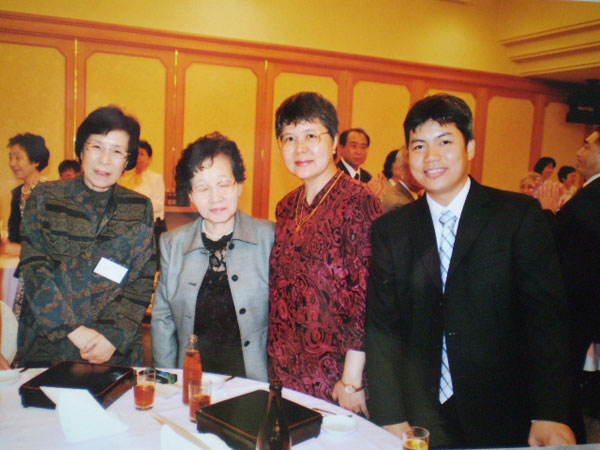
Nelson and parishioners
I have been here in Japan for more than two years now. I was given the opportunity to savor missionary life through the OTP (Overseas Training Program) of the Society of the Divine Word (SVD) and selected Japan as my one and only option to experience a missionary journey. At the beginning of my preparation, I thought it would be so easy to enter Japan knowing that I have an established organization as my sponsor. Yet, unexpectedly, it almost made me give up and leave the seminary. It took me four long months of waiting before I could apply for my visa.
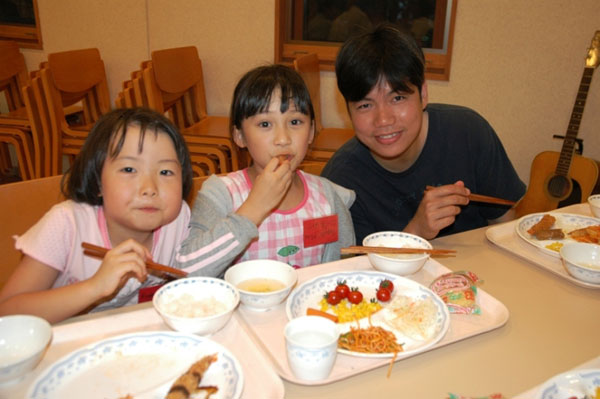
Nelson and Japanese kids
When I reached Japan, one of my regrets was that I hadn’t studied Japanese while waiting for my papers. At least I could have had some understanding before I get there and maybe speak even a little Japanese. My frustrations seemed to be a burden especially when three days after my arrival, I had to go to a Japanese language school. The first class was definitely a nightmare. I didn’t understand anything. The teacher spoke only Japanese and could hardly understand English. On my way home, the first time I used the subway train was also a humiliating experience. I was so confident that the station where I got off was the same station where I had got the train going to the school. But it wasn’t! I was like an army going to a war empty-handed. Thanks to the station official who, despite his meager English, by using some sign language was able to direct me to our house.
There were lots of strange things I saw and encountered during the first two weeks of my stay. In other words, I was experiencing culture shock. I was amazed to see young girls wearing shorts and loose shirts even in winter. I couldn’t imagine how they tolerated the coldness of the weather for the sake of fashion. Another thing was the hair styles of both young men and women. It seemed as if they had been watching anime or playing video games so often that they even imitated the hair styles of the characters there. It was so weird.
Because I was new to the environment, I also had to adjust to certain mechanisms in order to adapt to the new culture. What made it so difficult was the ‘inverted’ way of thinking as manifested in the Japanese language. I was used to the thought patterns of American English. I had to reorganize my brain and switch the way I thought. From that standpoint, even if I used a textbook in English, I still got a headache since the translation or explanation was often so awkward or sounded awful and grammatically illogical. I’m not saying that I have very good English. But being new to Japanese I had to rely on the explanations and translation in the textbook to understand. The day ended in frustration.
Many days had gone by and the so-called honeymoon stage was over. Due to international aspect of our community, I felt I was alone moving around and doing things on my own. I felt lonely and dry. Although there are Filipino SVDs in Japan, I couldn’t contact them easily because of their different assignments. They were busy all the time. However in the midst of the loneliness, I found a group of Filipinos in one of the churches where I regularly attended Mass. The priest who usually celebrated Mass for the international community was an SVD and invited me to join the choir and play the guitar for a couple of Sundays before I was invited to play at a Filipino Community Mass in the diocese. That was the start of my ministry extension although it was strongly discouraged by my director because my priority was to study Japanese. I was also reminded by a priest not to be so close to the Filipinos or else my Japanese would be in trouble. This reminder was really true and I can only guess as to how my Japanese is progressing right now. It is also true that studying Japanese isn’t easy. All kinds of pressures, psycho-emotional stress and many sleepless nights of review and practice of ‘kanjis’, the Chinese characters used in writing Japanese were all absorbed by my body during those times. Well, as I said to myself, this is what I had opted for and whether or not I regretted it, I was at the stage where I had to believe that I could overcome this hardship through the aid of the Almighty. Here in Japan I had to be independent. In spite the fact that I was living in a community, I had to be careful not to disturb the others. I had nothing to rely on other than God’s providential care and assistance.
The daily routine made me feel bored and dry. I felt that prayers or daily Mass weren’t enough to sustain a week’s bundle of home works and quizzes. My body needed to cool down and my spirit needed enrichment. I was longing for something and I believe it was my weekly apostolate when I was still in the Philippines. Luckily, I was again invited to play the guitar at a Filipino Mass in one of the parishes. I gladly accepted the invitation although my director allowed me only reluctantly. Due to my insistence and mission-oriented explanation I got his ‘Yes’ with the same reminders. After that, I got invitations to give a talk at a Lay Formation Seminar and to attend a regular Bible Sharing meeting. This helped ease the pressures at school and gave a chance to interact with the Filipinos in the diocese. I became their friend and sometimes they invited me for lunch or dinner. At least I had the opportunity to talk to them and listen to their stories about their dire sacrifices, daily work stresses and family-related issues. In one way or another, I was able to give them some good insights and enlightenment with the hope that God might bless them in everything they do.
I considered being present and available to listen to them as already a missionary journey. I didn’t realize that it also affected my personal and intellectual being as I too had to face my own concerns and issues.
Unlike Filipinos, Japanese people do not mind who you are, especially if you are a foreigner. Our family-oriented mind is definitely different from the Japanese way of thinking. For their part, it is their work that is the most important for if they don’t work they have nothing to live on. Family is only their second priority. The patriarchal culture is very evident in Japanese families. This causes problems for Filipino women who are married to the Japanese men. Although there are good husbands who are well-educated and understand certain situations, there are still serious cases of quarrels that lead to divorce.
From such experiences, from the preparation up to the present, I can draw the conclusion that God prepared me by delaying my papers in order to realize the outcome of my ministry in the future whether here in Japan or in another country. Here in Japan, I realize how difficult it is to live in a culture that is so deep and traditional. It’s not about doing missionary work to convert people but merely giving of one’s time to listen to and encourage the broken-hearted. The Japanese are also known for their ‘gaman wo suru’, which means patience or endurance. It is where I got a fruitful lesson to become calm and patient, qualities that a missionary has to have to be effective in the ministry. Humility also has to go with these two important qualities especially that I am studying language.
In spite of my weaknesses and shortcomings, God never leaves my side. He instead opens my heart and mind not to lose hope and to entrust everything to Him. He gives me the opportunity to stand and pick up the pieces broken by uncertainties. ‘For by his grace He stretches out to us his saving hands every time we fall and every time we tend to turn our back on Him. Let us just remember that God will never abandon us and He will continue to love us till the end of time.’
You may contact the author at nbarbarona@yahoo.com
Facts About Church in Japan
Population: 127,851,000; Catholics: 509,000; Percentage of population: 0.40.Number of archdioceses: 3, dioceses: 13.
Archdiocese of Tokyo: 18,408,577 people, 89,409 Catholics, 0.49%.
Archdiocese of Nagasaki: 1,500,249 people, 67,728 Catholics, 4.51% (highest).
Diocese of Takamatsu: 4,125,762 people, 5,407 Catholics, 0.13% (lowest).
Source: www.catholic-hierarchy.org . Statistics as of 2004, taken from Annuario Pontificio 2007. This is published by the Vatican each year.
Taro Aso, the previous prime minister of Japan, was the first Catholic, though not the first Christian, to hold that office.
Father Joeker
By Fr Joseph Panabang SVD
We noticed our hens didn’t want to lay their eggs in the baskets we had prepared for them. The parish priest, Fr Mietek Sagan SVD, from Poland, suggested we put one ping-pong ball in each basket to deceive them. It worked, only the color of the ping-pong ball is no longer immaculately white after being incubated twice.
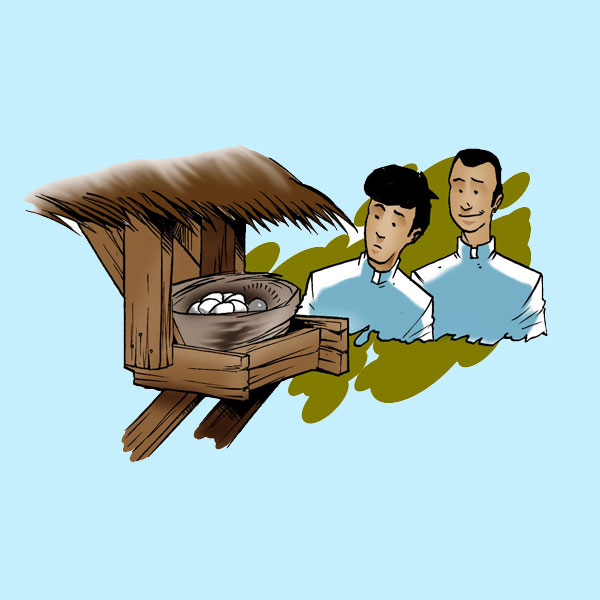
Asked why I celebrate my baptismal day, 21 September every year, I always relate the reasons tinged with emotion. According to my father, when I was two years old, I was sickly. They had actually given up on me. I was counted as dead for I couldn’t move or even cry. Providentially, a missionary priest belonging to the Congregation of the Immaculate Heart of Mary (CICM) came to our village. In those days your village was privileged if visited twice a year by the priest. As had always been the case, the baptism of infants followed the Mass. My father was urging my mother to bring me for baptism. After all, there was no hope. My mother had to cover me completely, except my forehead, perhaps out of shame because my father had said I was nothing but skin and bones. During the baptism when they lit all the candles, a sudden gust of strong wind blew off all the candles out except mine. Whether it was superstitious or not, from then on my parents strongly believed I would live, despite the fact that there was no immediate improvement at all after my baptism.
And one day out of the blue, a doctor was passing by on his way to the next village, Dacalan. As our house was at the entrance to the town, he accidentally saw me struggling inside. Without being asked, he told my parents that he had just one injection left and he wasn’t even sure if it was the right medicine. My father intervened, telling him to inject me anyway, which he did and left. The following morning, my father said I was asking for water. And from then onward, I started eating voraciously on the way to full recovery, like my candle surviving a strong wind.
The story has not yet ended. My father revealed to me that actually none of those baptized with me lived long. The last of them died at the age of six.
Now I understand why my father did not oppose my going to the seminary. Now I understand why my mother told me so confidently just before she died when I was only in Primary Two that of all her children I would one day be educated. All this because of the power of faith and hope in a lighted candle not blown out by the wind.
Fiji Day Celebrations In The Philippines
By Etuate Tubuka
Etuate, known as ‘Etu’, is Columban seminarian from Fiji studying in Quezon City.
I woke up in the morning of Saturday 11 October last year with a feeling of great delight and cheerfulness for it was the day we Fijians here in the Philippines were going to celebrate Fiji’s Independence from Great Britain. The actual date of independence is 10 October but since it fell on Friday, a working day, we decided to have the celebration the following day.
Exactly 134 years earlier Fiji was ceded to Great Britain due to unpaid debts to some Americans. Fijians then were living under the traditional chiefly system and money was of no value. People were tricked into the barter system where land could be exchanged for an axe or a bottle of whiskey. Settlers from Europe, America and Asia combed the Fijian shores and the trace of their blood still lingers in the Fijian population. At this time, a Fijian chief by the name of Seru Cakobau declared himself to be King of Fiji without consulting all the other chiefs. This was quite astonishing because chiefs were only respected in their own province or ‘vanua’ (in Fijian terms) and if someone crossed boundaries it meant war.
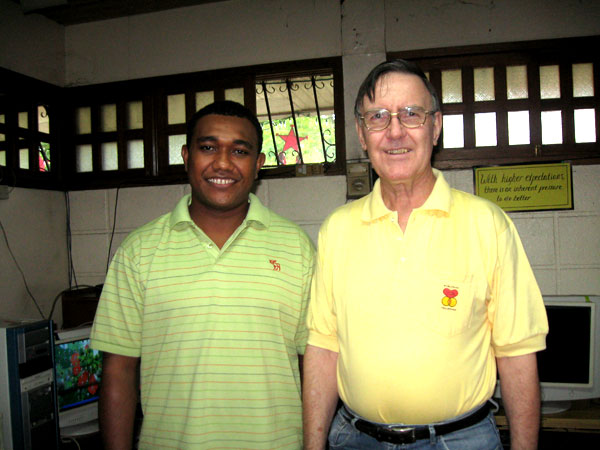
Etu with the Misyon Editor, Fr Sean Coyle
It was during this time that the house of Cakobau’s ally, an American, was razed to the ground. Cakobau was blamed for the fire and the looting that came with it. There was nothing he could do since he did not have money and the only solution was to seek help from another country. Therefore, on 10 October 1874 Cakobau and other chiefs of Fiji with heavy and sorrowful hearts signed the deed of secession to Great Britain and Fiji became a British Colony.
Thirty-nine years ago another deed was signed but with celebrations and joy. At 10 o’clock on the 10 October 1970 Fiji became known to the world as the Republic of the Fiji Islands.
38 years later we Fijian Columbans in the Philippines were handing out invitations to the Columban community here as well as to other Fijians and Pacific Islanders. The venue of the fiesta was the Columban House of Studies whose turn it was to host the community night as well as to show off their new basketball court with floodlights in which the entertainment was to be held.
The celebration began with Mass at 5pm in English and the liturgy was led by the Fijians with the help of ‘The Boys of 42’ (the Columban seminarians from 42 Rosario Drive, Cubao, QC). The main celebrant was Columban Father Vincent Ratnam, a Fijian, and he reminded the congregation of the importance of joy in life. The gospel that weekend was about a wedding feast and Father Vincent connected it to the theme and celebration of the day.
After Mass a traditional ‘kava’ (a Fijian traditional drink) ceremony of welcome was conducted. This was done to formally accept and welcome visitors and to show that we, the hosts, had no feelings of resentment towards them and at the same time we were asking God to protect them during their stay.
The highlight of the evening was the entertainment. While some were taking part in the dancing and clapping, others did the watching and laughing. For one hour everyone in their different colors danced to the Pacific beat until dinner was served.
Dinner was cooked in a lovo (earth oven), a traditional Fijian way of cooking in which the food is cooked by the steam of hot stones. Anything can be cooked in a lovo and in this case it was chicken, pork, fish, potatoes, cassava and palusami (taro leaves in coconut milk). Our cook produced some Filipino dishes and the Columban lay missionaries displayed their creativity with a touch of Indian cuisine. Thus everyone enjoyed a banquet fit for a king.
Everyone dispersed after dinner, happy, excited and fulfilled after a complete and lovely evening which all enjoyed. The Fijians continued their celebration with more kava and singing late into the night which brought back memories of home. It was a night to remember; I felt proud to be a Fijian.
You may email Etu at etubuka@gmail.com or write him at: Columban House of Studies, PO Box 4454, 1099 MANILA.
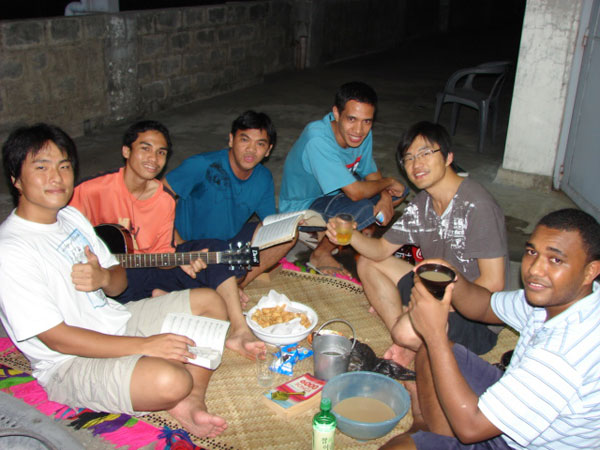
Kava Session
Yaqona or Kava Drinking
Yaqona, (pronounced ‘yangGOna’) otherwise known as kava, is an infusion prepared from the root of Piper methysticum, a type of pepper plant. It is extremely important in Fijian culture - in the time of the 'old religion' it was used ceremonially by chiefs and priests only. Today, yaqona is part of daily life, not only in villages but across the different races and in urban areas. 'Having a grog' is used for welcoming and bonding with visitors, for storytelling sessions or merely for passing time.There are certain protocols to be followed at a kava ceremony and in some remote villages, it is still a semireligious experience. Sit cross-legged, facing the chief and the tanoa, or large wooden bowl. Women usually sit behind the men and won't get offered the first drink unless they are the guest of honour. Never walk across the circle of participants, turn your back to the tanoa or step over the cord that leads from the tanoa to a white cowry (it represents a link with the spirits).
The drink is prepared in the tanoa. The dried and powdered root, wrapped in a piece of cloth, is mixed with water and the resulting concoction looks (and tastes) like muddy water. You will then be offered a drink from a bilo (half a coconut shell). Clap once, accept the bilo and say 'bula' (meaning 'cheers', or literally, 'life'), before drinking it all in one go. Clap three times in gratification and try not to grimace. The drink will be shared until the tanoa is empty. You are not obligated to drink every bilo offered to you, but it is polite to drink at least the first.
(Source: http://www.fiji.gov.fj/publish/history_culture.shtml )
Our Cover Story
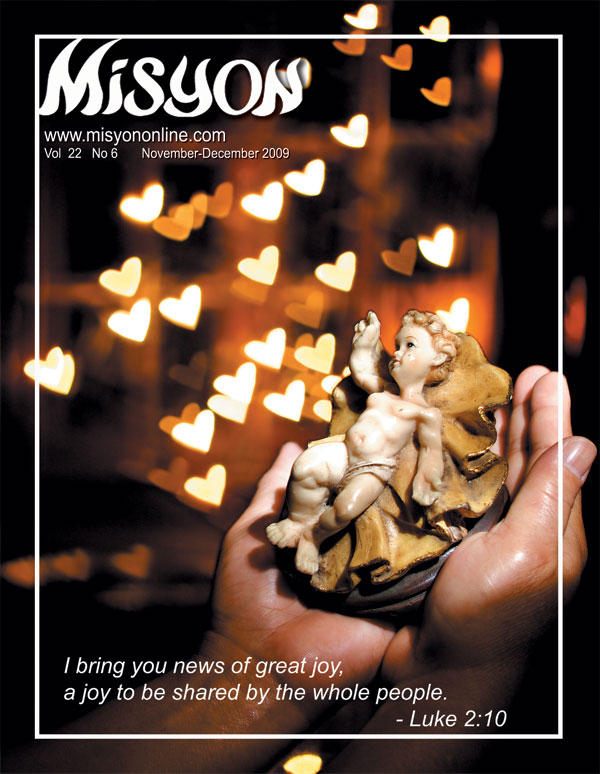
Our cover shows the Baby Jesus being held in two hands with heart-shaped lights in the background. It also includes a message from Luke 2:10, ‘I bring you news of great joy, a joy to be shared by the whole people.’
What do you think the image evokes? In what way can you say that Jesus is a gift to you? To mankind?
Our Hideaway
Asian Youth Day Cross visits the Young People of Bacolod
By Giovanni A. Solibio

The author, a teacher by profession, is a volunteer staff member of the Commission on Youth of the Diocese of Bacolod.
While staring at the Cross as it was being carried by some young people of Panay, a feeling of excitement and joy invaded my whole being. The noise of the crowd and the vehicles moving to and fro reminded me of the awesome presence of the Cross. I was so preoccupied then with how the Commission on Youth staff together with the council and the young people of Bacolod could provide accommodation for all. In spite of this, I was able to focus on the Cross as we commenced the caravan around the city passing the different schools with the welcoming students lining the streets. As the Cross visited every corner of each young person’s heart and soul, the power of the icon of God’s love for humanity was so vividly evident. I felt a desire of wanting Christ present to these young people and for the unfolding revelation of God`s love to all people. That very significant moment was strangely distinctive in the sense that it brought about a transfiguration, even for a short period of time, in the lives of the welcoming crowd.
I grabbed the special opportunity as the Cross stayed and remained present in a seat in Bacolod Cathedral. I gave my maximum participation in the evening vigil by joining the veneration of the cross and availing of the sacrament of reconciliation. Reflective prayer had drawn me into an intimate encounter with God at the foot of the Cross. It was a humble offering of all that I am to Him. It was also a great experience being with others praying as a community united in faith and love and seeing the young people expressing concretely their active involvement in social transformation as they marked their respective handprints on a cloth, signifying their commitment and stand for clean, honest, accurate, meaningful and peaceful elections in May. Hence, the presence of the Cross indirectly struck and eventually raised their conscious awareness on their vital roles as agents of change by sharing the word and living the Eucharist to others.
As the Cross continued its pilgrimage, it extended its healing visit to the young from the south to the north of the Diocese. The bad weather tried getting in the way, but it didn’t succeed. The activity was still pursued. This only showed that we all embraced the authentic essence of the Cross in our lives as a source of strength and hope amidst struggles and difficulties. It’s a reminder of God`s faithfulness which is anew every morning, renewed every day. It also assured us of the bountiful goodness of the Lord which never diminishes or runs out, a proof of His kindness and compassion.
As one of the volunteer staff of the Commission on Youth, my personal involvement in the activity and encounter with the holy cross did not only awaken my commitment in serving the young people but also inspired me to be a living witness of the broken Bread of Life that is Christ in my daily encounter with those I am called to serve.
Furthermore, it inspired me to fulfill what He has entrusted me to do: to preach the good news by word and deed. Finally, it provided me with the avenue to re-experience His loving presence and unfailing goodness which sustains my efforts in collaborating in His redemptive mission to all.
Indeed such experiences transcend my being and draw me to a divine holiness. Thanks for the AYD Cross. It was a transfiguring and grace-filled encounter with God.
You may email Giovanni at gvni_8190@yahoo.com
The Dioceses of Panay and Negros
The Archdiocese of Jaro is comprised of the provinces of Iloilo and Guimaras. The Diocese of San Jose de Antique takes in the province of Antique. The Diocese of Kalibo embraces the province of Aklan and the Archdiocese of Capiz the province of the same name.The Diocese of Bacolod is located in the northern part of the province of Negros Occidental and Kabankalan in the south while the Diocese of San Carlos takes in the eastern part of the province. The Diocese of Dumaguete includes the province of Negros Oriental and the island province of Siquijor. The people of these two dioceses are mainly Cebuano-speaking.
The ecclesiastical province of Jaro includes the Archdiocese of Jaro and the dioceses of Bacolod, Kabankalan, San Carlos and San Jose de Antique.
The ecclesiastical province of Capiz consists of the Archdiocese of Capiz and the dioceses of Aklan and Romblon. The latter covers the province of the same name.
The Diocese of Dumaguete belongs to the ecclesiastical province of Cebu.
Teachers' Guide
Dear Teachers,
‘I bring you news of great joy, a joy to be shared by the whole people’ (Luke 2:10). Such a beautiful promise of a gift from God!
In our day-to-day life, God’s manifestations come in different ways, sometimes in the most awesome appearance, sometimes in the simplest expression. But for the entire Columban community and for all concerned, the release of Fr Michael Sinnott, after being kidnapped on 11 October 2009, was such an early but the greatest Christmas gift. Yes, too early for us to celebrate Christmas as well as the Advent season as we look into the light of Father Mick’s captivity.
The invisible candles of Advent (candles of hope, preparation, joy and love) were lit up with all the prayers for Father Mick. We were waiting with hope and in deep faith for him. We were also trying to prepare ourselves for whatever outcome from a situation that was out of our hands. Now we are jubilant with overflowing joy as God has answered our prayers with Father Mick’s release on 12 November after a month in captivity. So we thank God for His wonderful expression of love. With all of these, we are shed with the light of ‘Christ Candle’, not only for those directly concerned but for the entire world to celebrate for God’s having used such a simple, peaceful man to bring about the message that He would want us all to learn and to witness.
May the God of the universe continue to manifest Himself to us in the very way that we can recognize His presence. May He grant us the eyes to see the beauty there is in every circumstance of our life, the lips to spread the Good News, the heart to love His people, and the being that will continue to shed His light on others.
In Christ’s love, Merry Christmas to all of you.

Our Cover
Our cover shows the Baby Jesus being held in two hands with heart-shaped lights in the background. It also includes a message from Luke 2:10, ‘I bring you news of great joy, a joy to be shared by the whole people.’
What do you think the image evokes? In what way can you say that Jesus is a gift to you? To mankind?
STUDENTS' WORKSHOP
‘Chaty’ for Charity Work is a simple story of generosity. She thought of reaching out to those in orphanages and other less fortunate ones with the help of the Filipino-Australian Association of Ballarat. This program is now in its fifth year.
Let her words 'Habang may buhay, mayroon akong ibibigay’ (‘As long as I live, I will always have something to give’) be ours too. It has been for us a usual thing to extend gifts and other Christmas presents to others as we perceive Christmas as a season of sharing, of giving, a season of love.
Encourage your students to do an outreach activity. Choose an orphanage, home for the aged, or any institution that would be good for an outreach activity. Or you can be of help to a certain adopted barangay. Ask them to bring some goods that the recipients surely need. Make a program of activities that your students are most capable of doing. Giving is the usual thing. So this time, make it a point of engaging them in conversation with the recipients. Maybe they can ask a little about their background and just take time to listen. For in this world of chaos and too much expression, sometimes people fail to listen. It is the heart of sharing through listening that will be a better gift than the material things given.
Your Turn is a comment made after reading the article The Road to Agoo. It shows how a story can reach out to someone at a distance.
With the many stories featured in past issues of Misyon, ask your students to pick out one article that really strikes them.
a. What was the story about?
b. What struck you most?
c. How do you relate it to your personal experience?
BRIDGING CULTURES
Fiji Day Celebrations in the Philippines
A Bridge between Taiwan and the Philippines
Fiji Day Celebrations in the Philippines is an article by a Fijian seminarian sharing with us how he and others were able to share their Fijian history and culture through the celebration of their Independence Day here in the Philippines. A Bridge between Taiwan and the Philippines is a story of the experience of 13 Taiwanese students who volunteered to do some service here and experience Filipino culture.
Have your students read the articles.
a. What do you think is the importance of inter-cultural activities?
b. What is the value enhanced in such encounters?
c. What have you learned from the stories?
d. Ask for one or two students to share a similar experience with the class.
YOUTH CORNER
A Bridge between Taiwan and the Philippines
The writer of Our Hideaway tells of his encounter with the Asian Youth Day Cross together with the young people of Bacolod. That experience made a big impact on him especially in his relationship with God, not discounting the work of the Holy Spirit in such a grace.
Encountering Jesus on the ‘Cross’ doesn’t have to take place in the object or image of the ‘Cross’ per se. But rather it can be in any event or through another image used by Jesus to tell you a message.
a. When have you encountered Jesus on the ‘Cross’?
b. What is most memorable about that meeting?
c. How did you feel about it?
Journalize your reflection.
A Bridge between Taiwan and the Philippines tells of ‘how the young teach the young.’ Organize a tutorial session with the depressed barangay or street kids. Prepare your students for this activity. Be sure to give each student the chance to share their little knowledge through a tutorial. After the activity, ask them to write a reflection paper for you to know how the activity contributed to their growth.
PRACTICAL FAITH
‘If the lay people have a proper appreciation for the unique role of the priesthood, they will join in the effort to encourage more priestly vocations.’ This was picked up by one of the readers in our Misyon forum so in our To Search is to Find a question on how a lay person can encourage more priestly vocations is asked. Just in time for us to reflect on as we are celebrating the Year of Priests. Have them read the article to at least make them familiar with the simple ways they can contribute to the Church. You may also ask them to visit http://www.misyononline.com/misyonforum/?q=node/905 to check for more random ideas.
Father Joeker items can be used as ‘ice-breakers’ or for motivating the class.
MISSION-BUILDING
A Taste of a Missionary Journey
It is never easy to go out of your own culture, of your own home, in the name of mission. A Taste of a Missionary Journey tells of the adventure of a seminarian in Japan through an Overseas Training Program (OTP). He shares with us the difficulties and challenges he encountered living ‘in a culture that is so deep and traditional.’
A Missionary from Colombia is a vocation story of a nun on how she lived her mission here in the Philippines. Even in her old age now, she remains ‘ever faithful and excited to learn more.’
The barriers experienced while in another place and culture will always remain a challenge to every missionary. But the beauty there is how they discover and see the hands of God in every event.
Of the articles,
a. To which part of the story can you relate yourself?
b. What is that piece of your experience that can tell of your own struggle?
c. How did you go about it?
d. All of us are called to partake in God’s Mission. At your age now, what do you think you can do as a missionary act?
FEATURING: ‘YOUTH OF THE NEW MILLENNIUM’
‘Youth of the New Millenium’ (Do you know where we’re going to . . ?) is written by a teacher telling us of her many observations about the youth of today. However, she doesn’t sound so positive about it. You can access the article at /nov-dec2009/youth_of_new_millennium.
In this connection we would like to cater responses from the youth on this article. We will be accepting entries either by email (editor@misyononline.com) or by post (San Columbano, PO Box 588, 6100 Bacolod City) on or before 31 December 2009. We will give three prizes of PHP1,000 for the responses that in the editor’s judgment are best.
We do hope that you will encourage your students to participate in this discussion that entails the concerns of the young generation.
To Search is to Find
Q. ‘If the lay people have a proper appreciation for the unique role of the priesthood, they will join in the effort to encourage more priestly vocations.’ I like this point very much. What specifically should I do to encourage more priestly vocations?
The question comes from a report on a talk that Pope Benedict gave on 17 September to a group of bishops from Brazil on the occasion of their ad limina visit. ‘Ad limina’ is the Latin for ‘to the threshold’. ‘Ad limina Apostolorum’ – ‘to the threshold of the Apostles’ - is the name used for the visit that diocesan bishops are required to make every five years to the Pope in which they give a report on what is happening in their dioceses and make a pilgrimage to the tombs of St Peter and St Paul. It is an expression of the unity of the Church.

My parents never suggested in any way that I should be a priest or even think about it. But my father was the one who took me to Mass on Sunday when I was very young while my mother looked after my baby brother and went to a later Mass. When I was older he used to bring me sometimes to Solemn High Masses and here in the churches of the Dominicans, Franciscans and Capuchins, when there would be solemnity, much singing and incense. He went to Mass each day right up to the day he died. I’ve no doubt whatever that this had a major part in the awakening of my vocation to the priesthood, which was God’s call to me.
My mother was sometimes critical of priests. This was probably the result of her being ordered out of the church with me when I was not yet three because I shouted ‘bah’ at the Baby Jesus in the crib during a weekday Mass after Christmas. She was pregnant with my brother at the time.
I admired the priests in our parish and saw the priest as the one who celebrated Mass and heard my confession every week. After 42 years as a priest I still see the Mass and the sacraments as being at the heart of the life of the priest. Pope Benedict said the same to the Brazilian bishops: ‘the role of the priest is essential and irreplaceable for the proclamation of the word and for the celebration of the sacraments, especially of the Eucharist, the memorial of the supreme Sacrifice of Christ who gives his Body and his Blood.’
Having regular prayer at home, such as grace before and after meals, teaching young children their prayers and praying with them, telling them stories from the gospels, praying each day that their children will discover whatever God’s call is and that they will joyfully follow it, are all things that parents can do. Parents cannot give their son or daughter their vocation. Only God can. Families can also invite a priest to their home for a meal, not necessarily on an occasion such as a birthday, when many people may be there, but just himself.
We need to pray each day that the men whom God is calling to be priests will be generous enough to answer his call and to pray for our priests, especially those whom we know and the priest(s) in our parish, that they will be faithful.
These are some random thoughts in response to the question.
YOUTH OF THE NEW MILLENNIUM
(Do you know where we’re going to . . ?)
By Felicidad D. Javier ‘Liit’ Javier last appeared in Misyon in the March-April 2008 issue when she recalled her time as an Associate Missionary of the Assumption in Cameroon. People nowadays trek the lonely road of isolation . . . fewer risks, no commitment . . . just me and my selfishness and the concept of my world behind the walls of reality and enveloped in many painful realizations. Just observing people’s habits and behavior, especially in the home among children and adults, I see the sad reality that, without our knowing, we are slowly going down the pit – that ‘sinkhole’ where we have built a little monster of character - insensitive, indifferent, defiant, self-serving and lacking in charity.
I check myself and saw that even I have succumbed to the easy way out, being very ‘un-neighborly’ (read: ‘walang pakialam’), looking in the other direction – that of complacency and mediocrity, mirroring the same monster I see in others. Are these ‘the signs of the times’? I have taught Catechesis/Religion in high school for ten years and tell myself that these students are the children of my generation, of my classmates. Their behavior and mindset come from their parents, my peers, and it is painful to see how things have regressed . . . the lack of moral values, of respect for elders or authorities, of appreciation for learning, their just being lax in everything they do. I ask myself what kind of value formation we’ve passed on to this young generation. Are we a failure when it comes to passing to the youth what we have received from our elders and teachers?
Did we lack the necessary tools or skills to become role models for them? How fast we have changed and adapted to this present culture of survival, of domination and manipulation! I wonder where it all started and how we can turn around if indeed there is some remote possibility of that ever occurring or happening. Ten years ago I felt the awareness that these values might become more acute like a rampant disease, but then my hopes were high that probably after the successful World Youth Day with Pope John Paul II in Manila in January 1995 things could get better. Unfortunately, what is acute now has become chronic and my consciousness speaks much more of fear and the lack of ability to do something to prevent further degradation. The youth of today have changed. They have built a new sense of identity that we adults have difficulty in understanding, eg, multi-tasking, ‘miss or over’, their use of gadgets in communication, their lack of identifying feelings or of plain sensitivity. How many of today’s youth fully understood how conscience can make and break them? They know but cannot assimilate, probably because they lack the ability to reflect and have not seen how it works due to a confused system of role modeling. They must have seen on occasion but this didn’t seem to have carried much weight or brought about a strong conviction for it to become a value or character.
As I write this, I have a strong feeling of apprehension that things will get worse before they can get better. The breakdown of morality in all sectors of society including the Church and especially in our homes is a stark reality we can’t continue to ignore, downsize or put up with for fear of ‘compromise’ because we are no longer sure that we are in control of the situation. Is there HOPE? Yes!!! And yes!!! BUT . . MAYBE and UNTIL . . . WE embrace the REALITY and the PROBLEM , no sugar-coating, no-defenses, but seeing things AS THEY ARE . . . in their MICRO OR MACRO STATE . . . This SOCIAL VIRUS in our homes, community and society as a whole will remain static, chronic and ever-growing if we don’t address it. If we are slowly doing something for our environment and the preservation of our eco-system, we must also focus on and get a grip on our value system. All of these things are interconnected in the web of life. If we see corruption macroscopically, we know in our hearts (microscopically) that we ourselves are corrupt too in one way or another. Perhaps, while we LOOK, let us SEE too – speak rather than talk, run through it rather than walk, gather our wits and find in our hearts and minds to re-create, re-store, re-form and re-solve the issue of morality – the basic values which our great-grandparents held dear and which kept their communities, homes and society ideal for human growth and development. All it takes is these WORDS: — I WILL DO IT (AKO MISMO??!) How? THE BEST I CAN . . . to the very point where GOODNESS HAS STARTED. It may be scary, but then, everything starts with a single step . . . the best shot! PRAYING FOR LUCK!!! AND more . . .! You may write Liit at: 83 M.H. del Pilar St, SFDM, 1105 Quezon City, Philippines, or email her at liitjav@yahoo.com
Your Turn
By Lu Mahino
Our letter sender, Lu Mahino, is from Kolambugan, Lanao del Norte and is presently based in Hong Kong. She is an active parishioner in Rosary Church parish, serving as lector and youth coordinator.

Sometime in September, Fr Eamon Sheridan, the assistant parish priest for the English-speaking congregation at Rosary Church, Kowloon, Hong Kong, posted the Misyon link on Facebook featuringThe Road to Agoo by ‘truknoiz’ (Kurt Pala). ‘Inspiring’ was the way Father Eamon, who is a member of the Columban General Council, which moved from Ireland to Hong Kong last year, described it.
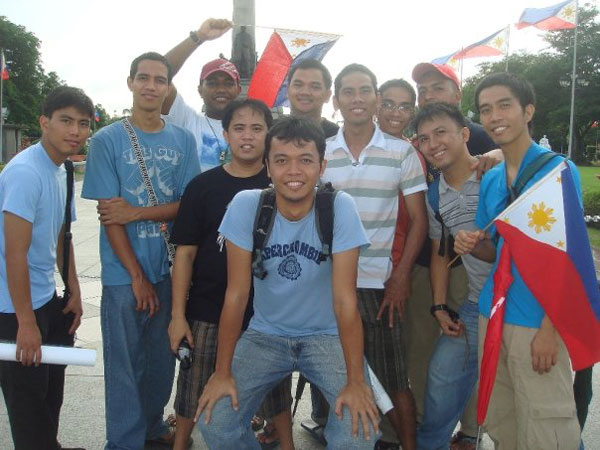
Thank you, Kurt. I've been going over your detailed account for the nth time and, like I said before, you really truly rock! You completed your pilgrimage within days and in the process ‘gained’ yourself. You will always have this experience to guide you, to fall back on - what a blessing! By sharing the experience with us, you in turn have become a blessing. For over a week now I’ve been depressed, and re-reading your article has somewhat reinforced my resolve to snap out of this rut.
God bless you, Kurt. You have the makings of a good priest.
Again, thank you, and thanks to Father Eamon who made it possible for me and my friends to whom I forwarded the link, to read about such an awesome experience.
You may contact Lu Mahino at ludillandra@yahoo.com
NOTE: To watch the video presentation of the article The Road to Agoo, pls click here.
**Lu recommends this site, www.wccm.org, for an alternative way of meditation and prayer.
‘Chaty' For Charity Work
‘Habang may buhay, mayroon akong ibibigay.’
By Mary Joy Rile
 A story about Mrs Mery Elgen ‘Chaty’ Harris from Bacong, Negros Oriental, near Dumaguete City, who is married with two children and lives in Ballarat, Victoria, Australia, where she works as a registered nurse in the Ballarat Health Service.
A story about Mrs Mery Elgen ‘Chaty’ Harris from Bacong, Negros Oriental, near Dumaguete City, who is married with two children and lives in Ballarat, Victoria, Australia, where she works as a registered nurse in the Ballarat Health Service.
Four years ago Chaty started a charity work by doing fund raising for an orphanage in Dumaguete. She collected some money from her friends back in Australia and bought goods such as rice, milk, sugar and biscuits as Christmas presents. Before returning to Australia she happened to pass by a second-hand store, popularly known here in the Philippines as ‘ukay-ukay’, where she saw a Salvation Army tag on some clothes. These were supposed to be given out free, not to be sold. This gave Chaty the idea for another charity work.
The following year, she distributed clothes to her neighborhood in Bacong and went to the charcoal makers in the mountain of Dauin, Negros Oriental. On December 24 she told her sister to invite these people to join them for Christmas lunch. A truckload of them came down to join her family in Bacong for a simple meal that made the heart s of everybody happy.
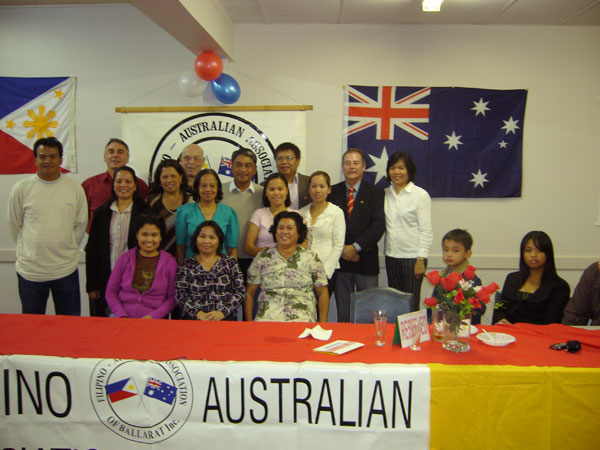
In December 2008 she came back to the Philippines to visit family and friends and of course to continue, even expand, the mission. She went back to the mountain of Dauin distributing clothes; she brought food and other goods to the orphanage in Valencia and fed a few of the street children of Dumaguete at a nearby restaurant.
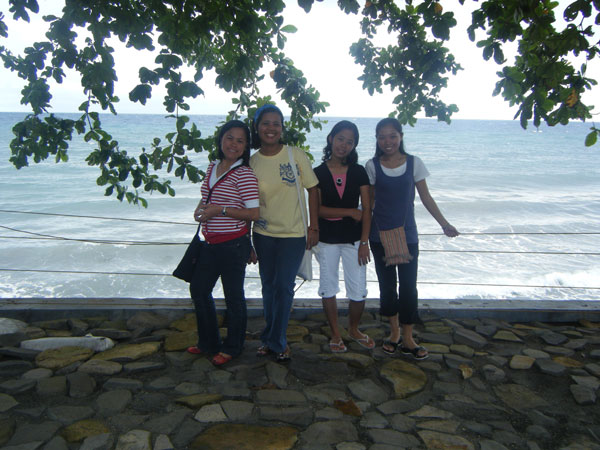
Chaty, Jessa, Dannah and Joy
While walking along the Boulevard in Dumaguete Chaty unexpectedly met a family who had been victims of a fire. The burns on the body of one child were clearly; such a pitiful sight. The family had come down to the city to ask for the help of the mother’s sister but they ended up with nothing. Chaty gave them clothes and enough money for their fare back to their home place.
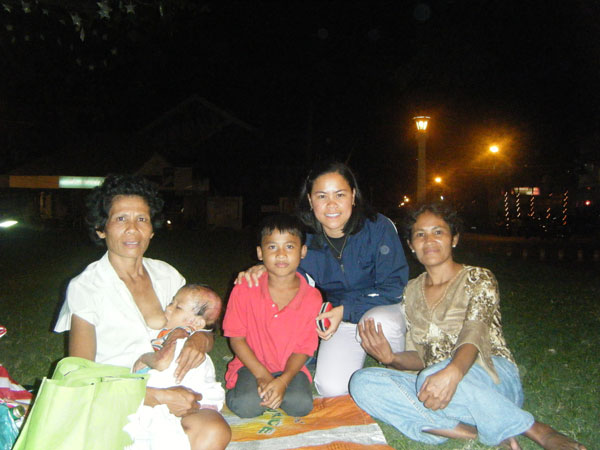
Victims of Fire at Boulevard
Later Chaty rode her motorcycle in her way to the convent. But before reaching her destination, she passed by an unconscious man who had met with an accident on the road. Worried about his condition, she brought him to the nearest hospital. She felt relieved when the man finally made a sound signaling that he was still alive. Happy with the opportunity to help, she said to herself that it was part of the mission that God wanted her to partake of.
She proceeded to the bus station and waited for Jessamine Calma, a Teresiana whom she met during the World Youth Day 2008 in Australia, Dannah her sister and me to arrive from Bacolod. [We had the privilege of visiting her and over dinner we talked about her day’s experience - such a long one but so memorable and fulfilling for her.
The next day we went to the hospital where she had brought the man but he had been already transferred to a public hospital. We also passed by the street where she had found the fire victims but they were no longer there. We hoped that they were finally back home.
Chaty was just a new-found friend when she invited us to her place. For the few days that we were together, I saw how easily she related to people. I saw her generosity, her love and determination in serving God by serving others. Having a well-off life right now, she remains simple and humble. ‘I am happier to be simpler. I am not rich in wealth but rich in heart.’
She traveled with us back to Bacolod and continued the mission with the orphans at Sto Niño Home and also with the children-recipients of Poveda Center -Bacolod.
In helping the less fortunate, Chaty always makes sure she explains to them that the help is not hers alone but that it also comes from the Filipino-Australian Association of Ballarat. They gather clothes, and the money they collect for her is spent here on school supplies and other basic needs of the mission.
When asked about her feelings in doing her mission she said, ‘First of all, before I engaged in this mission, I prayed to God to use me as an instrument of His love. I am very grateful that God has indeed used me, with the generous support of my husband Mark, some friends and the Filipino-Australian Association of Ballarat.’ Happy with the opportunity for charity work, she hopes and prays that may she be able to continue the mission until the end of her life. ‘Habang may buhay, mayroon akong ibibigay’ (‘As long as I live, I will always have something to give’) are the very words of her heart. To give heartily with simplicity and a smile is her living principle, and indeed it shows in and radiates from her face.
Chaty’s simple prayer in her everyday life: ‘Lord, here I am today. Use me as an instrument of your peace and love.’
You may email Chaty at meryelgen@gmail.com and Joy at editorialassistant@misyononline.com.